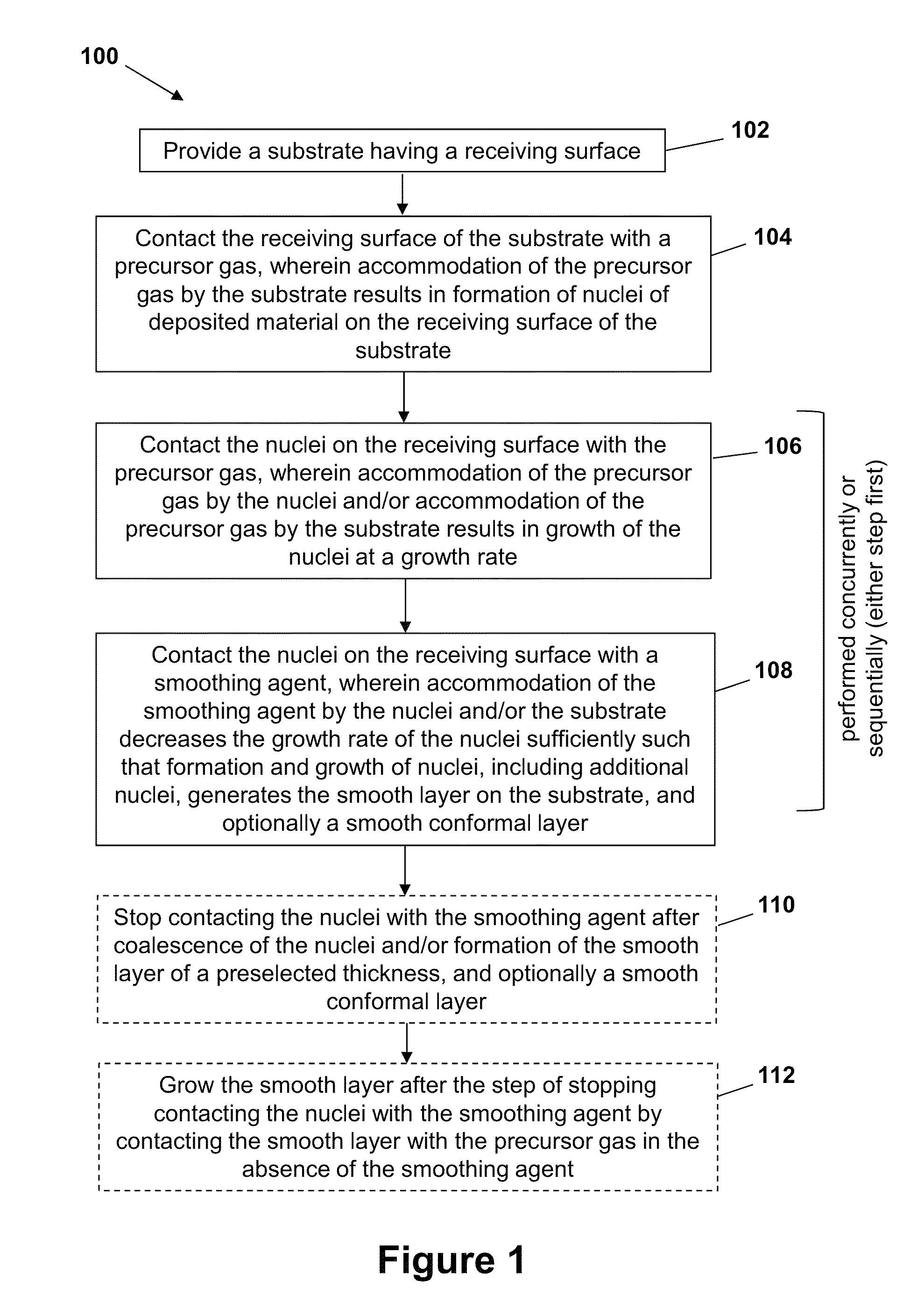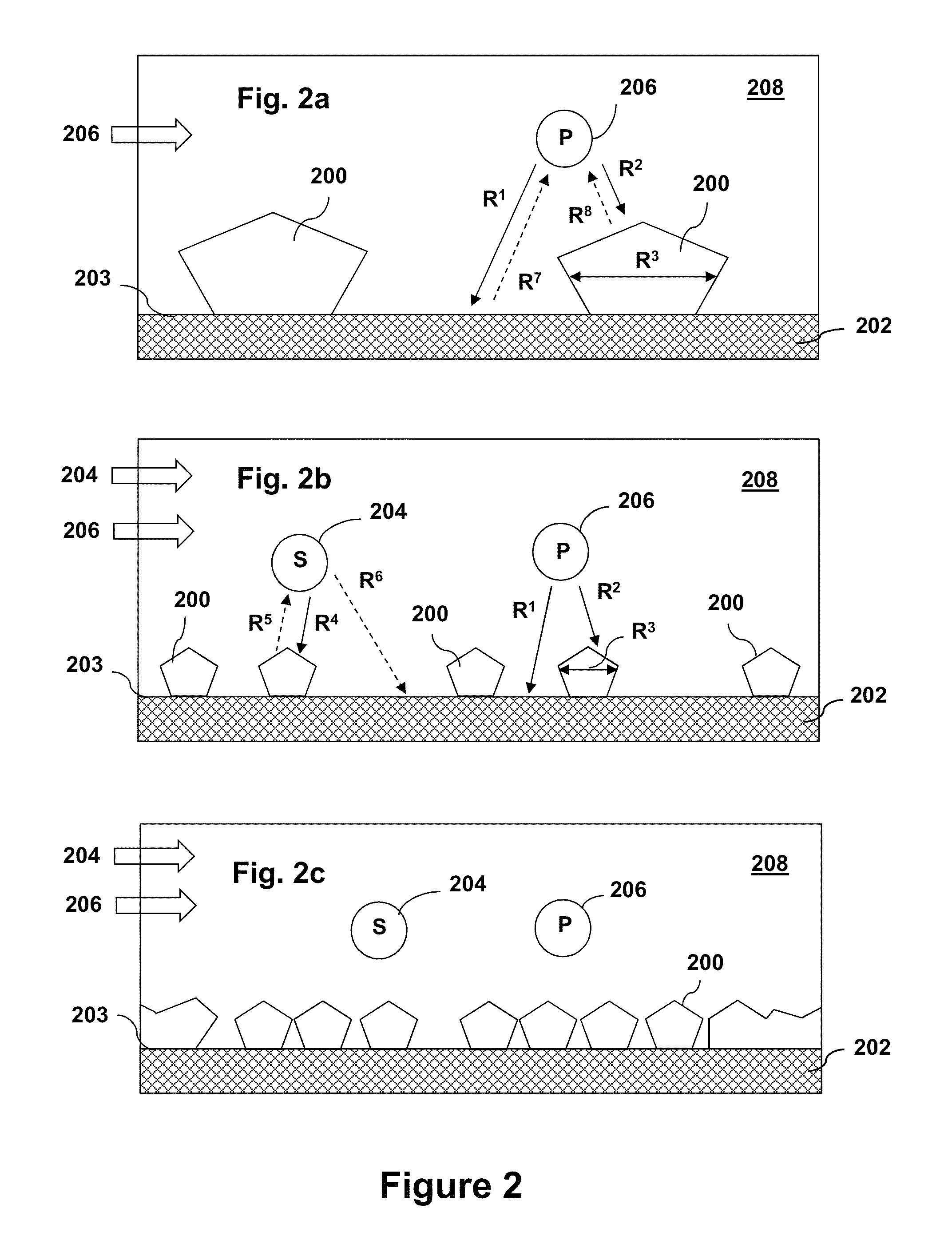Smoothing agents to enhance nucleation density in thin film chemical vapor deposition
a thin film chemical vapor deposition and nucleation density technology, applied in chemical vapor deposition coatings, metal material coating processes, coatings, etc., can solve the problems of reducing the overall device performance, reducing the uniformity of the device, and achieving the desired reduction of device dimensions, etc., to achieve enhanced nucleation densities, low surface roughness, and high degree of smoothness
- Summary
- Abstract
- Description
- Claims
- Application Information
AI Technical Summary
Benefits of technology
Problems solved by technology
Method used
Image
Examples
example 1
Low Temperature Chemical Vapor Deposition of Hafnium Nitride-Boron Nitride Nanocomposite Films
[0105]Nanocomposite HfNx—BN thin films are deposited by chemical vapor deposition at substrate temperatures of 350-800° C. using the precursor hafnium borohydride, Hf(BH4)4, in combination with ammonia, NH3. Below 350° C., the product is metallic HfB2 with essentially no incorporation of nitrogen. However, the presence of ammonia decreases the HfB2 deposition rate considerably; this growth suppression effect is attributed to blocking of reactive surface sites by adsorbed ammonia molecules. At substrate temperatures above 350° C., film deposition occurs; however, the HfB2 phase is completely absent. The resulting film stoichiometry is HfByN2.5; although the value of y is difficult to determine precisely, it is about unity. X-ray photoelectron spectroscopy (XPS) analysis detects Hf—N and B—N bonds but no Hf—B bonds; thus the films are nanocomposites that consist of a mixture of hafnium nitrid...
example 2
Growth Inhibitors to Enhance Nucleation Density in Thin Film Chemical Vapor Deposition
[0159]Many nanotechnologies, especially those involved in the fabrication of integrated circuits, require low temperature deposition of extremely thin, pinhole-free and ultra-smooth films that are conformal on high aspect ratio features such as trenches and vias [1]. Growth processes in which the reaction rate of the precursor species can be limited to very small values, such as chemical vapor deposition (CVD) or atomic layer deposition (ALD), can meet the requirement for conformality [2-6]. However, poor nucleation, especially on dielectric substrates, seriously degrades the morphology [7,8]: if the areal density of nuclei is low, then the initial film growth takes place in an island mode and the film does not fully coalesce until its thickness is much larger than acceptable for the device design. In addition, the coalescence of large islands produces a large initial surface roughness and the inte...
example 3
Nucleation and Growth of Cu Films Using Smoothing Agents
[0196]Nucleation and growth of thin Cu films on copper oxide substrates (e.g., CuO / CuO2) is examined using a Cu(hfac)vtms or Cu(hfac)MHY precursor in the presence and absence of a smoothing agent comprising vtms or MHY. These results are compared to experiments corresponding to growth of smooth HfB2 layers using Hf(BH4)4 precursor gas and an NH3 smoothing agent.
[0197]FIG. 14 provides AFM images of a HfB2 film fabricated according to exemplary methods of the present invention at three positions of a recessed feature (250 micron width, 1.5×104 micron depth) of a SiO2 substrate: (a) at the opening of a trench, (b) at the midpoint of an interior sidewall of the trench, and (c) at the bottom of the trench. The results in FIG. 14 demonstrate that the present methods provide substantially uniform nucleation along a recessed feature having aspect ratio of 60:1. Still referring to FIG. 14, the conditions employed are a macro trench: 250...
PUM
| Property | Measurement | Unit |
|---|---|---|
| surface roughness | aaaaa | aaaaa |
| surface roughness | aaaaa | aaaaa |
| thickness | aaaaa | aaaaa |
Abstract
Description
Claims
Application Information
 Login to View More
Login to View More - R&D
- Intellectual Property
- Life Sciences
- Materials
- Tech Scout
- Unparalleled Data Quality
- Higher Quality Content
- 60% Fewer Hallucinations
Browse by: Latest US Patents, China's latest patents, Technical Efficacy Thesaurus, Application Domain, Technology Topic, Popular Technical Reports.
© 2025 PatSnap. All rights reserved.Legal|Privacy policy|Modern Slavery Act Transparency Statement|Sitemap|About US| Contact US: help@patsnap.com



